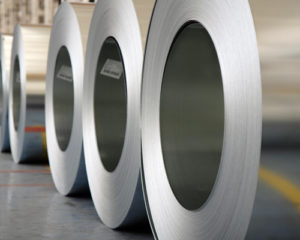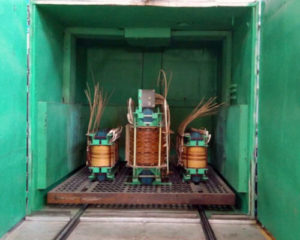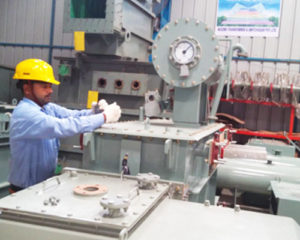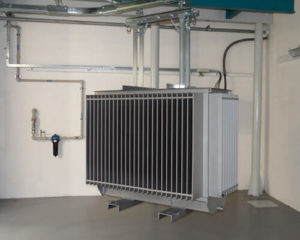Core :
The magnetic core of the transformer is built-up of cold rolled grain oriented (CRGO) steel lamination. Hi-B grade & laser scribed lamination is used to reduce the no load losses & noise level of transformer. Lamination are cut at an angle of 45Deg, Core Leg & Core yoke laminations are interleaved in mitred joints in order to facilitate the passage of magnetic flux & to avoid hot spots & reduce No Load Losses, No Load current & noise level.

Coil Winding :
The windings are designed to optimize dynamic, thermal, mechanical & electrical stresses depending upon the current & voltage requirements. Spiral crossover, Helical continuous disc, Fully or partly interleaved winding are used depending on the specific design criteria.
The winding machines are equipped with hydraulic break system which ensures the proper tension is maintained during the winding.
Dovetailed key spacers are employed to give the extra strength to the winding, Axial & radial cooling ducts in and between sections of the windings allow the free flow of transformer oil around the conductor.
Individual coils are dried & pressed to size in accordance with the calculated short circuit forces to obtain the design height & to guarantee full short circuit resistance.

Core & Coil Assembly :
The magnetic core with the windings and some accessories fitted together forms the active part of the transformer. The windings are slipped over the core legs & laminations of the upper yoke are interleaved.
All connections between windings and bushings & tappings to tap changer are made. the tap changer allows the increase or decrease of a certain no of turns in the high voltage winding in order to compensate for a voltage drop or to adopt the transformer to an unstable supply, so that the rated low voltage can be maintained.
Subsequently the top cover, on which the bushing for high voltage and low voltage are already fixed, is fitted.

Drying / Heating :
A transformer may contain no trace of humidity; otherwise there will be a danger of flash over within the windings.
The active part of transformer is completely dried before transformer is filled with transformer oil under vacuum.
The tank with active part in it, is connected to an oil supply and placed inside a vacuum chamber. A vacuum is applied & when the required vacuum is reached, the oil is admitted into the tank. The rising oil drives out any remaining air & the active part is completely immersed.

Tank & Tanking Process :
Our tank design is fully computerized. The computer determines the optimum size and the number and location of required tank supports. Occasionally the corners of the tank will be rounded off to further reduce the transformer weight without sacrificing quality and reliability.
The objective is to reduce the tank size and weight as much as possible, which facilitates easier handling, transportation, assembly and installation on site. All tanks are designed to withstand full vacuum and are manufactured from high- quality steel plate. The transformer can be designed with a welded or a bolted cover or as a bell type tank.
All metal parts are grit blast cleaned to remove weld splatter, mill scale and oxides, providing an excellent surface for the adherence of the primer and paint. The inside of the tank is painted with a white oil-resistant paint to create good visibility during internal inspection.
All metal parts are extensively tested on oil tightness via penetrant and pressure test at the tank manufacturer and with an extra 24 hours leakage test after complete assembly.

Surface Treatment & Painting :
We use satisfactory protection against corrosion & rusting, all surfaces of steel parts are shot blasted in compliance with Swedish Standard SIS 055900 to Sa 2.5 quality prior to painting. Thereafter tanks and steel parts are painted with one primer and two final coats with minimum thickness of 160 microns.

